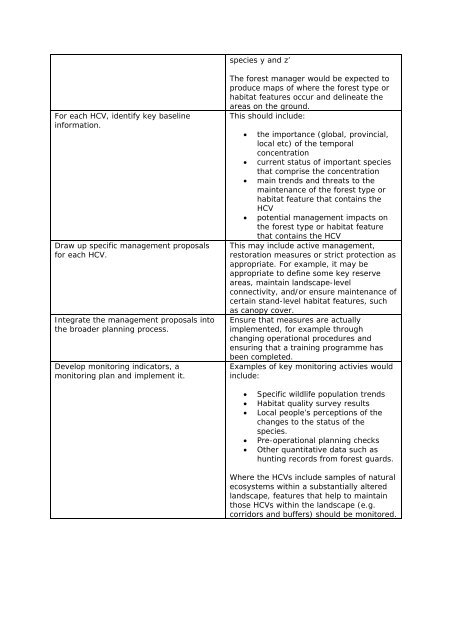English - HCV Resource Network
English - HCV Resource Network
English - HCV Resource Network
Create successful ePaper yourself
Turn your PDF publications into a flip-book with our unique Google optimized e-Paper software.
species y and z’<br />
For each <strong>HCV</strong>, identify key baseline<br />
information.<br />
Draw up specific management proposals<br />
for each <strong>HCV</strong>.<br />
Integrate the management proposals into<br />
the broader planning process.<br />
Develop monitoring indicators, a<br />
monitoring plan and implement it.<br />
The forest manager would be expected to<br />
produce maps of where the forest type or<br />
habitat features occur and delineate the<br />
areas on the ground.<br />
This should include:<br />
• the importance (global, provincial,<br />
local etc) of the temporal<br />
concentration<br />
• current status of important species<br />
that comprise the concentration<br />
• main trends and threats to the<br />
maintenance of the forest type or<br />
habitat feature that contains the<br />
<strong>HCV</strong><br />
• potential management impacts on<br />
the forest type or habitat feature<br />
that contains the <strong>HCV</strong><br />
This may include active management,<br />
restoration measures or strict protection as<br />
appropriate. For example, it may be<br />
appropriate to define some key reserve<br />
areas, maintain landscape-level<br />
connectivity, and/or ensure maintenance of<br />
certain stand-level habitat features, such<br />
as canopy cover.<br />
Ensure that measures are actually<br />
implemented, for example through<br />
changing operational procedures and<br />
ensuring that a training programme has<br />
been completed.<br />
Examples of key monitoring activies would<br />
include:<br />
• Specific wildlife population trends<br />
• Habitat quality survey results<br />
• Local people’s perceptions of the<br />
changes to the status of the<br />
species.<br />
• Pre-operational planning checks<br />
• Other quantitative data such as<br />
hunting records from forest guards.<br />
Where the <strong>HCV</strong>s include samples of natural<br />
ecosystems within a substantially altered<br />
landscape, features that help to maintain<br />
those <strong>HCV</strong>s within the landscape (e.g.<br />
corridors and buffers) should be monitored.

















